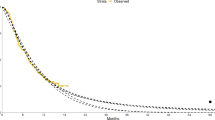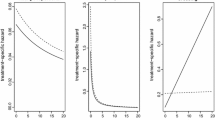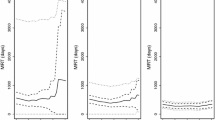Abstract
Medical treatments often take a period of time to reveal their impact on subjects, which is the so-called time-lag effect in the literature. In the survival data analysis literature, most existing methods compare two treatments in the entire study period. In cases when there is a substantial time-lag effect, these methods would not be effective in detecting the difference between the two treatments, because the similarity between the treatments during the time-lag period would diminish their effectiveness. In this paper, we develop a novel modeling approach for estimating the time-lag period and for comparing the two treatments properly after the time-lag effect is accommodated. Theoretical arguments and numerical examples show that it is effective in practice.


Similar content being viewed by others
References
Andersen PK, Gill RD (1982) Cox’s regression model for counting processes: a large sample study. Ann Stat 10:1100–1120
Bain L, Englehardt M (1991) Statistical analysis of reliability and life-testing models: theory and methods, vol 115. CRC Press, New York
Chen Z, Huang H, Qiu P (2016) Comparison of multiple hazard rate functions. Biometrics 72:39–45
Cheng MY, Qiu P, Tan X, Tu D (2009) Confidence intervals for the first crossing point of two hazard functions. Lifetime Data Anal 15(4):441–454
Cox DR (1972) Regression models and life-tables. J R Stat Soc Ser B (Methodol) 34(2):187–220
Dinse GE, Piegorsch WW, Boos DD (1993) Confidence statements about the time range over which survival curves differ. Appl Stat 42:21–30
Fleming TR, Harrington DP (1991) Counting processes and survival analysis. Wiley, New York
Klein J, Moeschberger M (2005) Survival analysis: techniques for censored and truncated data, 2nd edn. Springer, New York
Lin X, Wang H (2004) A new testing approach for comparing the overall homogeneity of survival curves. Biom J 46(5):489–496
Liu K, Qiu P, Sheng J (2007) Comparing two crossing hazard rates by cox proportional hazards modelling. Stat Med 26(2):375–391
Mantel N, Bohidar NR, Ciminera JL (1977) Mantel-Haenszel analyses of litter-matched time-to-response data, with modifications for recovery of interlitter information. Cancer Res 37(11):3863–3868
O’Quigley J (1994) On a two-sided test for crossing hazards. Stat 43:563–569
Park K, Qiu P (2014) Model selection and diagnostics for joint modeling of survival and longitudinal data with crossing hazard rate functions. Stat Med 33:4532–4546
Qiu P, Sheng J (2008) A two-stage procedure for comparing hazard rate functions. J R Stat Soc Ser B (Stat Methodol) 70(1):191–208
Therneau TM, Grambsch PM (2000) Modeling survival data: extending the cox model. Springer, New York
Zucker DM, Lakatos E (1990) Weighted log rank type statistics for comparing survival curves when there is a time lag in the effectiveness of treatment. Biometrika 77(4):853–864
Acknowledgements
The authors thank the editor and two referees for their valuable comments which greatly improved the quality of this paper.
Author information
Authors and Affiliations
Corresponding author
Electronic supplementary material
Below is the link to the electronic supplementary material.
Rights and permissions
About this article
Cite this article
Park, K., Qiu, P. Evaluation of the treatment time-lag effect for survival data. Lifetime Data Anal 24, 310–327 (2018). https://doi.org/10.1007/s10985-017-9390-7
Received:
Accepted:
Published:
Issue Date:
DOI: https://doi.org/10.1007/s10985-017-9390-7




